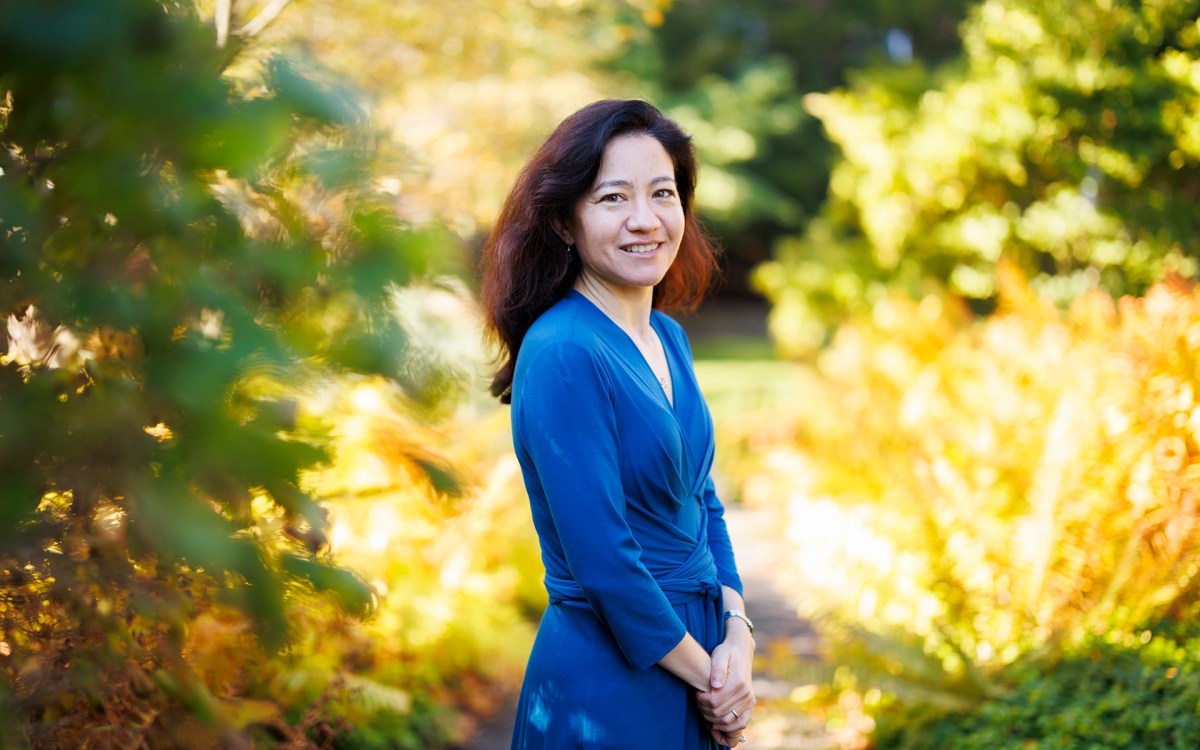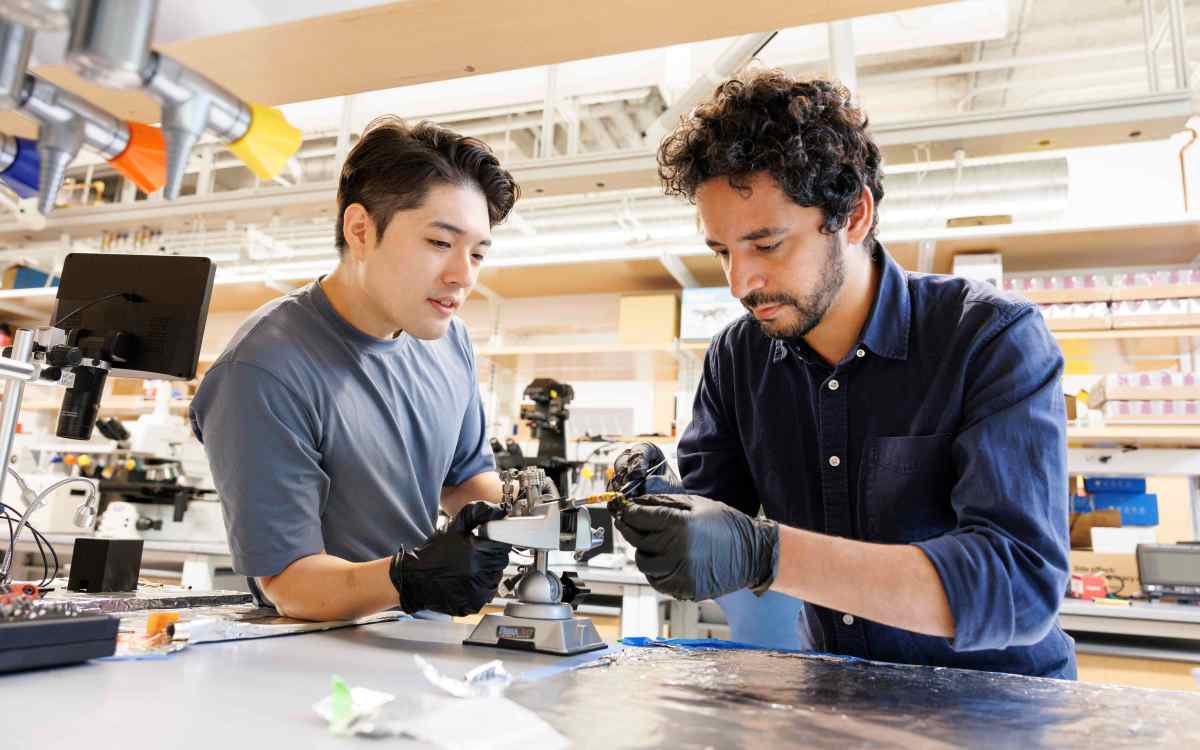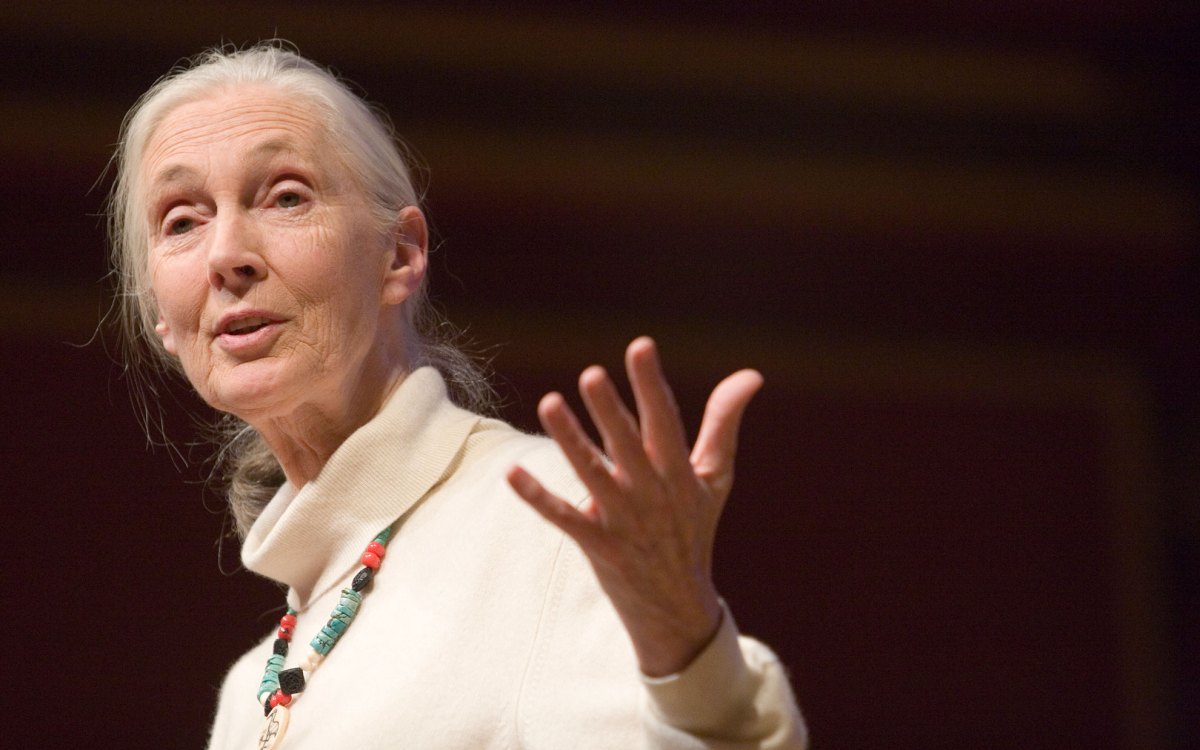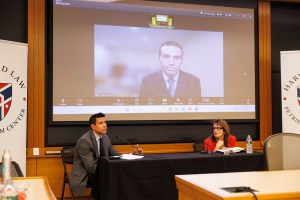Science & Tech
-

Harsh past might bare its teeth
Early adversity leads to higher aggression and fearfulness in adult canines, study says

-

What will AI mean for humanity?
Scholars from range of disciplines see red flags, possibilities ahead
-

‘Human exceptionalism is at the root of the ecological crisis’
Saving the planet requires getting over ourselves, argues author of ‘The Arrogant Ape’
-

Lauren Williams awarded MacArthur ‘genius grant’
Math professor honored for theoretical breakthroughs with sometimes surprising applications across phenomena such as tsunamis, traffic
-

-

‘She had a sense of caring for everybody that she encountered.’
Richard Wrangham remembers his teacher and colleague Jane Goodall as a force of science, empathy, and hope
-
Student makes cableless cable
Matthew DePetro ’05 earned top honors for his senior design project, “Wireless Cable Television.” The first-prize entry “untethers” standard cable TV and even eliminates the need for a wall outlet.…
-
Simulations show growth of black holes
Using a new computer model of galaxy formation, researchers have shown that growing black holes release a blast of energy that fundamentally regulates galaxy evolution and black hole growth itself.…
-
E.O. Wilson, “Ant Man”
E. O. Wilson reflects on insect societies, human society, and the importance of biodiversity.
-
Message to marathoners: Watch your fluid intake!
The study singled out substantial weight gain while running, long race duration, and a lower body mass index as the primary risk factors for hyponatremia in runners. Researchers suggest that…
-
Case of Sedna’s ‘missing moon’ solved
In trying to solve the riddle of Sedna’s “missing moon,” scientists Scott Gaudi, Krzysztof (Kris) Stanek and colleagues at the Harvard-Smithsonian Center for Astrophysics took measurements that have cleared up…
-
Scientists find molecular pathway suspected in precancerous stomach lesions
Ramesh Shivdasani, M.D., Ph.D., of Dana-Farber, said the finding “opens a window that could help us eventually interfere with these pathways when they become abnormal. It should give us a…
-
Human skull is 7 million years old
When a 7-million-year-old skull was first found, Daniel Lieberman, a professor of anthropology at Harvard, called it “one of the greatest discoveries of the past 100 years.” After studying new…
-
Prof. Lene Hau: Stopping light cold
In 2005, Professor Lene Hau did something that Einstein theorized was impossible. Hau stopped light cold using atoms and lasers in her Harvard lab.
-
Astronomers measure slowest motion across the sky
“A snail crawling on Mars would appear to be moving across the surface more than 100 times faster than the motion we measured for this galaxy,” said Mark Reid of…
-
Study identifies mechanism of resistance to targeted therapy in lung cancer patients
Gefitinib acts on the receptor for the epidermal growth factor protein (EGFR) to halt the spread of cancer cells by fitting into the activating pocket of the protein, blocking the…
-
In China, gems used as tools millennia earlier than thought
Researchers have uncovered strong evidence that the ancient Chinese used diamonds to grind and polish ceremonial stone burial axes as long as 6,000 years ago – and incredibly, did so…
-
High school AP courses do not predict college success in science
A survey of 18,000 college students enrolled in introductory biology, chemistry, and physics has found little evidence that high school Advanced Placement (AP) courses significantly boost college performance in the…
-
Functional protein changes caught and quantified
Just knowing that a protein is expressed in a cell does not reveal what it is up to; increasingly, the chemical modifications it undergoes are the key to understanding its…
-
Most Milky Way stars are single
Common wisdom among astronomers holds that most star systems in the Milky Way are multiple, consisting of two or more stars in orbit around each other. Common wisdom is wrong.
-
Racial, ethnic gap in youth violence linked to social factors
A study conducted by Robert J. Sampson of Harvard University and Jeffrey D. Morenoff and Stephen Raudenbush of the University of Michigan shows that the longstanding gap in the racial…
-
Tiny RNA molecules fine-tune the brain’s synapses
Non-coding regions of the genome – those that don’t code for proteins – are now known to include important elements that regulate gene activity. Among those elements are microRNAs, tiny,…
-
Interns crash more after long shifts
A safety group at Harvard University has looked into the behavior of those in training in hospitals and found that overworked interns made 36 percent more serious medical errors and…
-
Growing supermassive black holes from seeds
Astronomers announced Jan. 12, 2006 that they have found the first sample of intermediate-mass black holes in active galaxies – a discovery that will help in understanding the early universe.…
-
New maser measurements trace detail in active galactic core
The roiling cores of many active galaxies are difficult to see in detail because of surrounding gas and interstellar dust. Smithsonian astronomers announced Jan. 12, 2006, however, a first-time measurement…
-
Astronomers spot the Great Orion Nebula’s successor
Astronomers announced Jan. 11, 2006, that they have found the next Orion Nebula. Known as W3, this glowing gas cloud in the constellation Cassiopeia has just begun to shine with…
-
See-through galaxy
To peer into the galactic center of our own Milky Way galaxy, astronomers Silas Laycock and Josh Grindlay used the unique capabilities of the 6.5-meter-diameter Magellan Telescope in Chile. By…
-
Going beyond Einstein
Observations by two astronomers confirm one important theory about how a black hole’s extreme gravity can stretch light. The data also paint an intriguing image of how a spinning black…
-
Scientists find black hole’s ‘point of no return’
By a score of 135 to zero, scientists using NASA’s Rossi X-ray Timing Explorer have compared suspected neutron stars and black holes and found that the black holes behaved as…
-
Spitzer puts a new spin on the Helix Nebula
Helix Nebula (NGC 7293) is a challenging stargazing target for amateur astronomers. It is one of the closest planetary nebulas – a type of nebula formed from gas ejected by…
-
New calculations suggest economic cost of Iraq war much larger than previously recognized
A paper presented to the annual Allied Social Sciences Association meeting in Boston, in a session jointly sponsored by the American Economic Association and the Economists for Peace and Security,…
-
When oil became black gold
Texas, Alaska, Russia, the Middle East – these are the regions one is likely to think of when asked to name the world’s top oil- producing areas. Galicia, an area…
-
Studying Boston’s race trends
Guy Stuart, an associate professor of public policy at the Kennedy School of Government, is the author of a new study, “Boston at the Crossroads: Racial Trends in the Metropolitan…
-
Method automates capture of cell image data
A new type of drug profiling will be useful in identifying the biological targets of experimental compounds and predicting drug toxicity. “This work brings microscopy into the ‘omics’ era,” said…
-
Alien treasures in our backyard
Astronomers have gained an important clue to guide their hunt for extrasolar worlds. And that clue points to the unlikeliest of places — our own backyard. “It’s possible that some…
-
Taking a CAT scan of the early universe
Reporting in the Nov. 11, 2004, issue of Nature, astrophysicists J. Stuart B. Wyithe (University of Melbourne) and Abraham Loeb (Harvard-Smithsonian Center for Astrophysics) have calculated the size of cosmic…


